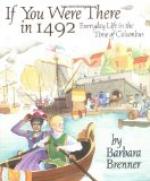About the year 1470 Columbus arrived at Lisbon. According to the account given by his son, and adopted by the historian Bossi, he had sailed with Colombo el Mozo (the nephew of that “first Admiral of the family” of whom we have already heard) on a cruise to intercept some Venetian merchantmen on their way home from Flanders. At break of day the battle began, off Cape St. Vincent, and lasted till nightfall. The privateer commanded by Columbus grappled a huge Venetian galley, which, after a hand-to-hand struggle, caught fire, and the flames spread to the privateer. Friends and enemies alike sought safety in the sea, and Columbus, supporting himself on an oar, succeeded, when nearly exhausted, in gaining the land, which was at some six miles distance. God preserved him, says his son, for greater things.
Columbus at Porto Santo.
It was probably not long after this that he married Donna Felipa Munnis Perestrelo, who was residing at the convent of All Saints, in Lisbon, where he was a regular attendant at the services of the church. She was a daughter of that captain of Prince Henry’s who has been already mentioned as the first governor of Porto Santo. On that island, after a short residence in the Portuguese capital, Columbus took up his abode, busying himself with the papers of his deceased father-in-law, and earning a livelihood by making maps and charts for sale. It is a curious fact that the great chief of American discoverers should thus have inhabited a spot which was the first advanced outpost in African discovery. He was here on the high road to Guinea, and being in constant communication with the explorers of the new regions, it was likely that he would become imbued with some of their enthusiasm for adventure.
The bishop of ceuta; return of the caravel.
Shrouded in obscurity as this period of his life remains, we are only able to find vague traditions of the unsuccessful effort which Columbus made to induce the Senate of Genoa to take up his project. From the Portuguese crown he could scarcely look for help, embroiled as it was in costly wars, and having already a field for discovery along the African coast, which it would scarcely be wise to forsake for an undertaking similar in kind, but more hazardous and less definite. However, King John the Second, to whom Columbus applied, seems to have listened with attention to the exposition of his scheme, and indeed, according to the account of Fernando, to have given a sort of qualified promise of his support, but to have disagreed with Columbus as to terms. The king referred the matter to a Committee of Council for Geographical Affairs, before whom Columbus laid his plans; but it is possible that even in the fifteenth century Boards had come to regard projectors as their natural enemies, and the report of the Committee was entirely adverse to the scheme




